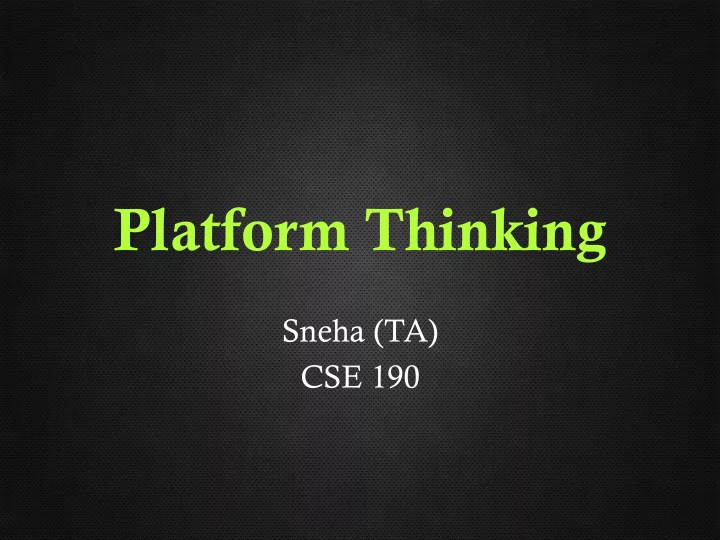

Platform Thinking Sneha (TA) CSE 190
Case Studies
Uber’s Dynamic Pricing • Increase cost based on – Wait times – # unfulfilled requests • Incentive to increase supply • Intentionally decrease demand • Maintain quality • Lead to 70-80% increase in supply
What’s with Groupon’s model ? • Too much focus on short term growth • It’s not a win-win-win situation – Customers never come back to deal places – Owner ends up loosing money • Current evaluation lower than Google’s offer
A story of Pivots Autowale
Business Model 1 • Transaction cut per trip – convenience fee • Pros – Low liability – Easy entry to market • Cons – Low driver engagement – Low profit margins
Business Model 2 • Driver pays upfront deposit and Autowale guarantees business to driver • Pros – Increased revenue compared to 1 – Drivers engaged • Cons – Optimization of trip allocation doesn’t lead to profits
Business Model 3 • Buy driver miles at 50% rate and lease autos • Pros – Improvements in allocation leads to profitability – High profit margins • Cons – Low demand leads to loss
Platform Startups Content from Sangeet Paul Choudhary’s website
Traditional Biz. – Pipeline Model • Linear model • Producers – create a valuable product • Consumers – pay a price for the value • Optimize process to make profits • Eg. Encyclopedia, Television
The Internet is Changing this ! Diminishing gap between producers & consumers
Platforms - Networked Model USERS create value Firm just provides infrastructure Eg. Wikipedia, Youtube
Example – App Market
Example – AirBnb
Example – YouTube
Example – Twitter
Interactions are key Producers Consumers Interactions (Supply) (Demand) Platform
Key Components Producers Consumers Interactions (Supply) (Demand) 1. Magnet Get the two roles on board !
Magnet • Chicken and egg problem • Think of the first user • Convert consumers to producer • How do producers produce more • Incentives – fun, fame, money
Key Components Producers Consumers Interactions (Supply) (Demand) 2. Toolbox Build the right technology to ease interactions
Toolbox • Focus on interactions • Reduce friction from production to consumption • Go iteratively one interaction at a time • Eg. Linkedin – Professional to professional – adoption – Professional to recruiter – monetization – ToughtLeaders - enagement
Key Components Producers Consumers Interactions (Supply) (Demand) 3. Matchmaker Use data to match the two roles
Monetization • Transaction Cut – AirBnb • Pay for access – Dating websites – Spotify • Pay for attention – Ad – Facebook – YouTube
References • http://abovethecrowd.com/2014/03/11/a- deeper-look-at-ubers-dynamic-pricing- model/ • http://seekingalpha.com/article/1242821- groupons-problem-is-not-the-ceo-its-the- business-model
Recommend
More recommend